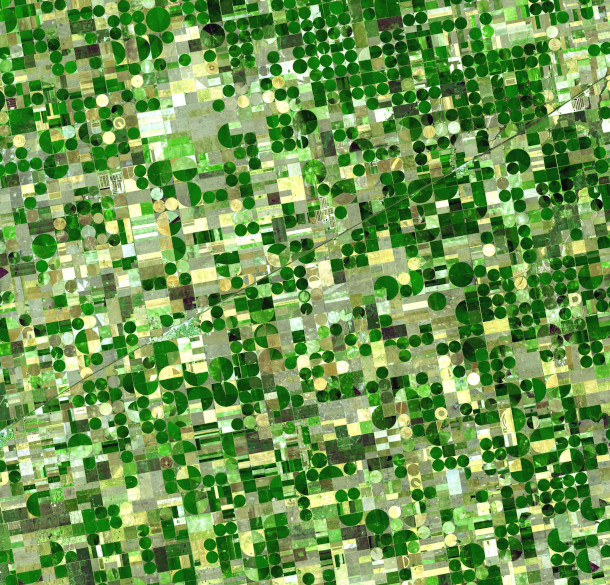Beyond the Headlines
Air Date: Week of July 21, 2023

UPS drivers are threatening to strike if the Teamsters union cannot strike a deal with the company by July 31. One reason for the impending strike is unsuitably hot working conditions. (Photo: Mike Mozart, Flickr, CC BY 2.0)
This week, Living on Earth Contributor Peter Dykstra joins Host Aynsley O’Neill to discuss the threatened UPS driver strike and how extreme heat is making conditions inside UPS trucks unbearable. They also cover the “greenhushing” some companies are engaging in. And in history, they look back to when a patent was granted for center-pivot agriculture, making the desert bloom with huge green circles of crops.
Transcript
O'NEILL: It's time now for a look beyond the headlines with Peter Dykstra, our Living on Earth contributor. Peter joins us from Atlanta, Georgia. Hey, Peter, how are you doing down there in that Georgia heat?
DYKSTRA: It's a really, really hot week, Aynsley. The forecast is from 95 to 100 degrees, unless you're a UPS driver, when the back of your truck can be 130 degrees. That was an issue in the potential strike at the end of the month by the Teamsters union, which represents UPS drivers. I have this great UPS driver that comes through every weekday named Mike, and he tells me it's sweltering back there. That was an issue that actually got tentatively resolved between the Teamsters and the company. But if the strike goes through over pay issues, then nothing is resolved and you'll have a lot of sweaty, suffering UPS drivers in this warmer, warmer weather.
O'NEILL: Yeah, hopefully they can find some sort of resolution that leads to better pay and better AC.
DYKSTRA: And getting my packages would be nice, too.
O'NEILL: And, Peter, what else do you have for us this week?
DYKSTRA: Well, a lot of folks who listen to this program are familiar with the concept of greenwashing. It's been around for decades. It's the effort of big companies to tell us all that they're not messing up the environment, somebody else is. Now there's an opposite of greenwashing. You want to know what that is?

“Greenhushing” is when a company chooses to hide its environmental goals and commitments to avoid public backlash. (Photo: Pixabay, CC0)
O'NEILL: I don't know, Peter, what are you talking about?
DYKSTRA: The opposite of greenwashing is “greenhushing.” And that's something that's come about because there are some major companies that may be trying to actually do something about their carbon output, or their use of plastic, but they want to keep quiet about it instead of spending millions to brag about it. They've taken their good works off their website, maybe bragged a little bit less about it in commercials.
O'NEILL: All right, so they're doing good works in secret, sounds pretty good to me.
DYKSTRA: It also sounds pretty counterintuitive after decades and decades of greenwashing. But the issue here is that some major companies are afraid to brag about their environmental virtue, because they're afraid they'll be slapped by the same right-wing organizations that have taken Budweiser to task because Bud Light had the temerity to do a campaign with a trans activist. And those major companies think the same thing will happen if they somehow diss fossil fuels.
O'NEILL: All right, then, Peter, what do you have for us from the history books this week?

Center pivot irrigation creates circular fields of crops. Center-pivot irrigation systems revolutionized agriculture around the world by making marginal farmland more productive. (Photo: NASA, Wikimedia Commons, Public Domain)
DYKSTRA: July 22, 1952, Frank Zybach is awarded a U.S. patent, patent number 2,604,359, for what was called a self-propelled sprinkling irrigating apparatus. Now, in plainer English, that's known as center-pivot agriculture. In mid-America, if you're up in the air, and you look down, you will see these huge circular farm fields being irrigated by a moving hose. And they've changed the face of agriculture, not only in America, but around the world, because marginal land, land that doesn't get enough water, is now in wide use. One of the other things it's doing is draining aquifers, like the Ogallala aquifer that covers most of the middle of the United States and is running dangerously low. So, the good news for agriculture is bad news for the environment. And once again, we have a conflict that started out by an ingenious and well-intended invention.
O'NEILL: All right, well, thank you for bringing us these stories, Peter. Peter Dykstra is a Living on Earth contributor. Thanks again, and we'll talk to you soon.
DYKSTRA: All right, Aynsley. Thanks a lot, talk to you soon.
O'NEILL: And there's more on these stories on the Living on Earth website. That's loe.org.
Links
NPR | “UPS Workers Facing Extreme Heat Win A Deal To Get Air Conditioning In New Trucks”
Washington Post | “‘Greenhushing’: Why Some Companies Quietly Hide Their Climate Pledges”
Living on Earth wants to hear from you!
Living on Earth
62 Calef Highway, Suite 212
Lee, NH 03861
Telephone: 617-287-4121
E-mail: comments@loe.org
Newsletter [Click here]
Donate to Living on Earth!
Living on Earth is an independent media program and relies entirely on contributions from listeners and institutions supporting public service. Please donate now to preserve an independent environmental voice.
NewsletterLiving on Earth offers a weekly delivery of the show's rundown to your mailbox. Sign up for our newsletter today!
 Sailors For The Sea: Be the change you want to sea.
Sailors For The Sea: Be the change you want to sea.
 The Grantham Foundation for the Protection of the Environment: Committed to protecting and improving the health of the global environment.
The Grantham Foundation for the Protection of the Environment: Committed to protecting and improving the health of the global environment.
 Contribute to Living on Earth and receive, as our gift to you, an archival print of one of Mark Seth Lender's extraordinary wildlife photographs. Follow the link to see Mark's current collection of photographs.
Contribute to Living on Earth and receive, as our gift to you, an archival print of one of Mark Seth Lender's extraordinary wildlife photographs. Follow the link to see Mark's current collection of photographs.
 Buy a signed copy of Mark Seth Lender's book Smeagull the Seagull & support Living on Earth
Buy a signed copy of Mark Seth Lender's book Smeagull the Seagull & support Living on Earth

